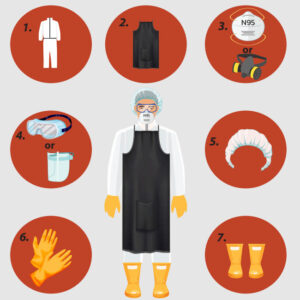Battling Pandemic Viruses Like Avian Influenza
Authors: Maggie L. Bartlett, PhD, and Sten Vermund, MD, PhD
The increasing number of avian influenza spillovers to non-bird species demands innovation to prevent a future influenza pandemic. As deadly as the coronavirus pandemic has been, the catastrophic potential of influenza viruses is much worse. The 1918-1919 influenza pandemic infected a third of the world’s population and claimed over 50 million lives. Today’s concerning increase in avian influenza spillovers echoes that history. Avoiding another pandemic is crucial, like remembering to turn off the stove before leaving the house; let’s not burn down the globe with another round of “Viral Variants: The Sequel.” Let’s take the lessons learned from our recent hard-fought global battle to ensure we face future viral threats with resilience and strategic prowess.
Collaboration, innovation, and knowledge-sharing especially are needed to address the risk of another potential pandemic. To this effort the Global Virus Network (GVN) stands at the ready with a tour de force of influenza experts who meet regularly and are poised for rapid action and response. This global consortium of virologists includes many of the most renowned and innovative scientists of the age. By combining that wealth of knowledge, the GVN stands uniquely positioned to leverage experts in a way and on a scale as never before.

A CDC graphic from "Protect Yourself From H5N1 When Working With Farm Animals"
As always, implementing stringent biosafety protocols, particularly in live animal markets and the livestock and poultry industries, can reduce the risk of disease transmission. It is also essential to develop and enforce strict hygiene practices for workers and visitors, including easily accessible handwashing stations and or hand sanitizers. For poultry and livestock facilities, maintaining controlled access to reduce potential contamination risks, quarantine protocols for new animals, education of farm workers on biosecurity, and regular testing of animals for infectious agents (followed by prompt isolation, treatment, or culling) are key.
However, given that the pandemic among animals (panzootic) of avian influenza has been underway for years, preventing a human pandemic from avian influenza also requires innovation in data-gathering and data-wrangling. A Texas dairy worker infected with bird flu in March demands we not forget the potential for zoonotic transmission risks poised, too. So, among the recent technologies to employ are drone-based monitoring systems, artificial intelligence (AI)-driven analytics, social media-based surveillance, and blockchain technology data management. Further, improving surveillance, biosafety, and transparency in wild and domestic animal populations from birds to pigs to cats and everything currently capable of harboring a virus would help establish an early warning system for potential threats. This can be achieved by setting up additional sentinel sites for wastewater surveillance of pathogens, which has been a harbinger of notice since poliovirus campaigns.
What keeps an outbreak from becoming an epidemic or keeps an epidemic from becoming a pandemic is a quick threat assessment and a short response time. To dramatically increase those capacities will take investments in the aforementioned technologies and in undertaking surveillance studies in wildlife to monitor circulating viruses, exploring genetic makeup transmission dynamics in their natural reservoirs, and having clear criteria for public health responses to viral surveillance. Increased investment in innovative research on viral ecology and host-pathogen interactions can help predict and prevent potential spillover events, safeguarding human health and animal health, too. This investment will pay for itself. After all, the average total economic burden to the U.S. alone is estimated at $11.2 billion in a typical year, underscoring the cost-benefit of resolving influenza viruses entirely.
By embracing innovation, collaboration, and a spirit of discovery, we can turn the tide against avian influenza, safeguard biodiversity, and build a resilient world where health and well-being thrive. So, we believe that more scientific engagement between nations will help us all achieve these global goals for pandemic prevention. Indeed, together we can make the next global health story a triumph rather than a tragedy.
Maggie L. Bartlett, PhD, is Program Director of the GVN and on the faculty at Johns Hopkins Bloomberg School of Public Health.
Sten Vermund, MD, PhD is President of the GVN and serves as the Anna M.R. Lauder Professor of Public Health, Dean Emeritus of the Yale School of Public Health, and professor in pediatrics at the Yale School of Medicine.
